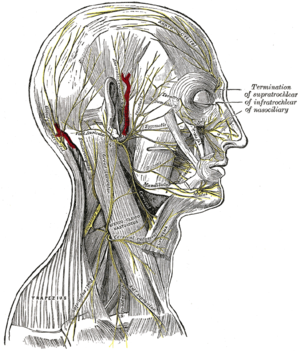Anatomy and Structure of the Facial Nerve
- The facial nerve emerges from the pons of the brainstem.
- It travels through the facial canal in the temporal bone.
- The nerve exits the skull at the stylomastoid foramen.
- The facial and intermediate nerves are collectively referred to as the nervus intermediofacialis.
- The greater petrosal nerve provides parasympathetic innervation to several glands.
- The communicating branch to the otic ganglion joins the lesser petrosal nerve.
- The nerve to stapedius provides motor innervation for the stapedius muscle.
- The chorda tympani provides parasympathetic innervation to sublingual and submandibular glands.
- The chorda tympani also supplies taste fibers for the anterior two-thirds of the tongue.
- The cell bodies for the facial nerve are grouped in nuclei or ganglia.
- Afferent nerve cell bodies are found in the geniculate ganglion.
- Muscular efferent nerve cell bodies are found in the facial motor nucleus.
- Parasympathetic efferent nerve cell bodies are found in the superior salivatory nucleus.
- The facial nerve is derived from the second pharyngeal arch.
- It supplies motor and sensory innervation to muscles formed by the second pharyngeal arch.
- The motor division of the facial nerve originates from the embryonic pons.
- The sensory division of the facial nerve originates from the cranial neural crest.
- Taste fibers for the anterior two-thirds of the tongue are supplied by the chorda tympani branch.
Functions of the Facial Nerve
- The main function of the facial nerve is motor control of facial expression muscles.
- It also innervates muscles such as the posterior belly of the digastric and stylohyoid.
- The facial nerve receives taste sensations from the anterior two-thirds of the tongue.
- Taste sensation is sent to the gustatory portion of the solitary nucleus.
- General sensation from the anterior two-thirds of the tongue is supplied by the fifth cranial nerve.
- Supplies parasympathetic fibers to the submandibular and sublingual glands, increasing saliva flow.
- Provides parasympathetic innervation to the nasal mucosa and lacrimal gland.
- Functions as the efferent limb of the corneal reflex.
- Carries axons for general somatic afferent (GSA) to the skin of the posterior ear.
- Carries axons for general visceral efferent (GVE) to the sublingual, submandibular, and lacrimal glands.
Clinical Significance - Facial Nerve Palsy
- Acute facial nerve paralysis can result in facial paralysis.
- Bells palsy is a type of idiopathic acute facial nerve paralysis, often caused by viral infection or Lyme disease.
- Iatrogenic Bells palsy can occur due to incorrectly placed dental anesthesia.
- Surgery, such as cross facial nerve graft or masseteric facial nerve transfer, may be performed to restore facial movement.
- Facial nerve decompression surgery is sometimes done in cases of facial nerve compression.
Examination of the Facial Nerve
- Voluntary facial movements test the facial nerve, including wrinkling the brow, showing teeth, frowning, closing the eyes tightly, pursing the lips, and puffing out the cheeks.
- Upper motor neuron lesion (central seven) affects the lower part of the face on the contralateral side.
- Lower motor neuron lesions can result in CN VII palsy, causing weakness in both upper and lower facial muscles on the same side.
- Taste can be tested on the anterior two-thirds of the tongue using a flavored solution or electronic stimulation.
- The corneal reflex tests the proper functioning of both cranial nerves V and VII, involving consensual blinking of both eyes in response to stimulation of one eye.
Additional Information
- Inferior view of the human brain shows labeled cranial nerves, including the facial nerve.
- Mandibular division of the trigeminal nerve is shown.
- The course and connections of the facial nerve in the temporal bone are depicted.
- Images show the surface markings for the tympanic antrum, transverse sinus, and facial nerve in the left temporal bone.
- Illustrations display the branches of the facial nerve and deep dissection of the nerve.
The facial nerve, also known as the seventh cranial nerve, cranial nerve VII, or simply CN VII, is a cranial nerve that emerges from the pons of the brainstem, controls the muscles of facial expression, and functions in the conveyance of taste sensations from the anterior two-thirds of the tongue. The nerve typically travels from the pons through the facial canal in the temporal bone and exits the skull at the stylomastoid foramen. It arises from the brainstem from an area posterior to the cranial nerve VI (abducens nerve) and anterior to cranial nerve VIII (vestibulocochlear nerve).
| Facial nerve | |
|---|---|
 The course of the facial nerve is shown here | |
 The nerves of the scalp, face, and side of neck. | |
| Details | |
| From | facial nerve nucleus, intermediate nerve |
| To | greater superficial petrosal nerve, |
| Innervates | Motor: Muscles of facial expression, posterior belly of digastric, stylohyoid, stapedius Special sensory: taste to anterior two-thirds of tongue Parasympathetic: submandibular gland, sublingual gland, lacrimal glands |
| Identifiers | |
| Latin | nervus facialis |
| MeSH | D005154 |
| NeuroNames | 551 |
| TA98 | A14.2.01.099 |
| TA2 | 6284 |
| FMA | 50868 |
| Anatomical terms of neuroanatomy | |
The facial nerve also supplies preganglionic parasympathetic fibers to several head and neck ganglia.
The facial and intermediate nerves can be collectively referred to as the nervus intermediofacialis.
facial nerve (plural facial nerves)